Let's learn how to make dill oil at home: preparation instructions and rules for using dill oil
Dill is known not only for its pleasant taste, but also for its medicinal properties. The plant has long been recognized by folk and official medicine. Greens and seeds are used to prepare cosmetics and are added to dishes.
In this article we will tell you how to make dill oil at home. You will learn about its beneficial properties and contraindications for use.
What is dill oil
Dill seeds and the green part of the plant contain a large amount of aromatic compounds. Dill oil is prepared from them, which has a spicy aroma and medicinal properties.
Vegetable oils and lard are used as a basis, and the distillation method is also used to obtain essential oil. The product is used in folk healing, cosmetology and cooking.
Beneficial features
The product has a beneficial effect on the human body. When used correctly, the product:
- accelerates the healing of wounds, cuts and burns;
- eliminates signs of herpes;
- relieves skin diseases;
- protects against viruses during an epidemic of colds;
- has a laxative effect;
- relieves spasms in the gastrointestinal tract;
- speeds up metabolism;
- normalizes digestion;
- relieves headache attacks;
- relaxes;
- enhances breast milk production.
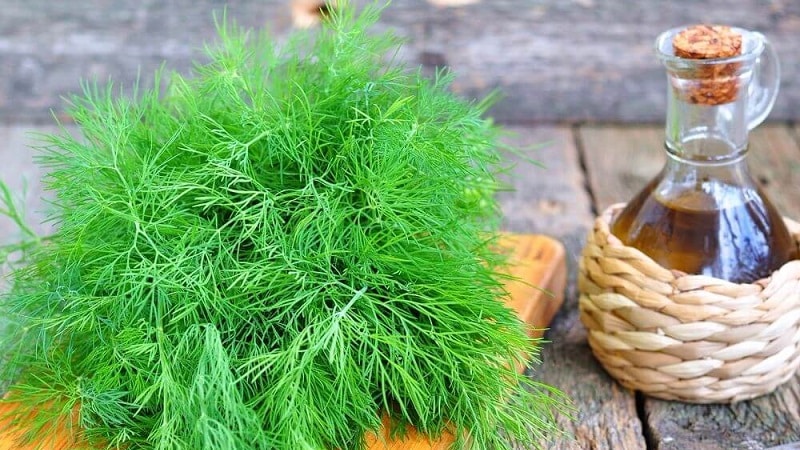
Cooking at home
The product can be easily made with your own hands using virgin vegetable oils and lard. The concentrate distillation method is available to those who have a distiller.
Based on vegetable oil
For cooking, use corn, sunflower, olive, pumpkin, flaxseed or sesame oil. There are no restrictions in this regard. Just remember that the product must be unrefined, namely first-pressed with a smell. It is in it that the beneficial properties of the plants from which it was squeezed are preserved.
Step-by-step instruction:
- Take dry dill seed and grind it into flour using a coffee grinder.
- Pour into a clean, dry container and fill with vegetable oil in a 1:1 ratio.
- Place the jar in a dry place. Shake the product every day to maximize the extraction of biologically active substances.
- After three weeks, strain the oil through cheesecloth, squeeze and pour into a bottle. Store in a cool, dark place.
There is another recipe for making a product that is used in cooking. To do this, green twigs are crushed using a blender and the juice is filtered through cheesecloth. It is then evaporated over low heat until the volume is reduced by half.
In a separate container, bring the vegetable oil to a boil in a water bath and mix with dill juice in equal parts. After cooling, pour into a bottle and store in a dark place.
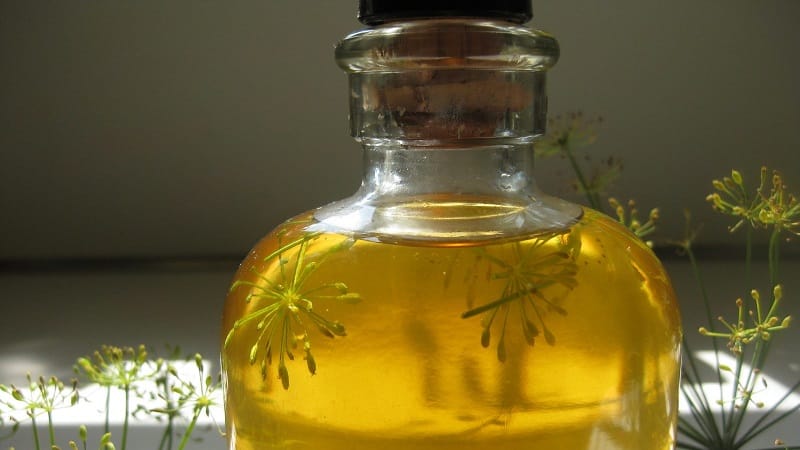
Lard based
To prepare the product in this way, take seeds and lard in equal proportions.
Grind the dill seeds into flour. Twist the lard through a meat grinder. Mix both components and place in a glass container. You should end up with a product that resembles an ointment in consistency. Store in the refrigerator.
Butter with fresh dill
This wonderful snack is very easy to prepare:
- Wash and dry fresh dill.
- Finely chop with a sharp knife and combine with softened butter.
- Add sea salt, a little lemon juice and stir. For piquancy, you can use garlic passed through a press.
- Wrap the mixture in parchment paper and form into a sausage. Store in the refrigerator or freezer.
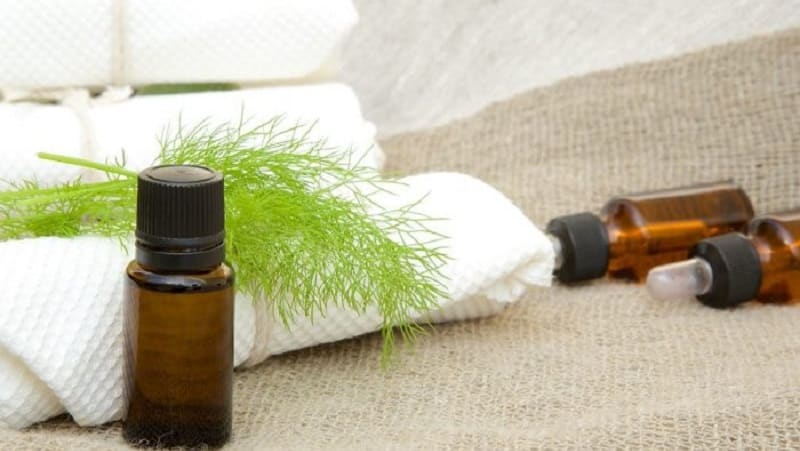
Essential dill oil
The preparation process has its own specifics; it will be very difficult to do this at home. It is easier to purchase essential oil at a pharmacy or Ayurvedic store.
Those who have a special distiller at home can try making it themselves.
First of all, prepare the raw materials: seeds and herbs. Fill the container with it, leaving a hole for steam to escape. Pour cold purified water into the device.
Distillation of raw materials starts from the moment water boils. Your task is to constantly monitor the water level and add another portion if necessary.
Once the process is complete, filter the concentrate through a natural dry cloth. Pour the liquid into a dark glass bottle and seal tightly.
The yield of the finished product is 4-6%. The liquid, prepared according to all the rules, has a yellowish tint and the aroma of fresh dill. At the very beginning, bitter notes are felt, and then sweetish ones.
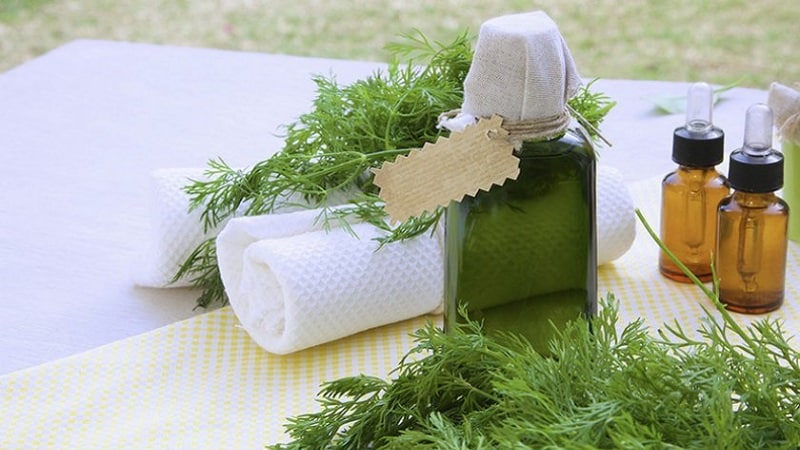
How to use it
Dill oil has a wide range of uses. It is consumed internally and used externally.
In folk medicine
Oil based on dill seeds and greens is used for therapeutic purposes for:
- Improvement of digestive processes. Dilute one drop in a glass of water and drink 2 hours a day.spoons after each meal.
- Eliminate flatulence. In 1 tbsp. add 2-5 ml of dill essential oil to a spoonful of liquid honey. Frequency of administration: three times a day. The second method is to mix 1 teaspoon of a plant-based product with 5 tbsp. spoons of water. Take 1 tbsp. spoon after eating.
- Treatment of dry cough for asthma and colds. Place a few drops of the concentrate on a piece of refined sugar, place it under your tongue and dissolve.
- Acne treatment. Dissolve three drops of the product in a glass of water. Use as a facial toner. The oil can also be used in its pure form for spot application to problem areas.
- Normalization of sleep. Rub in circular motions into your temples before bed.
- Treatment of pyelonephritis and cystitis. Dilute 1 teaspoon of concentrated product in 40 ml of water. Take three times a day until the condition improves.
- Increased breast milk production. Dilute eight drops in a glass of warm water and drink. Take three times daily.
- Getting rid of bad breath. Dilute ten drops in a glass of water and rinse your mouth morning and evening.
Important! Dill essential oil is a wonderful antispasmodic. The product quickly relieves nervous and muscle tension.
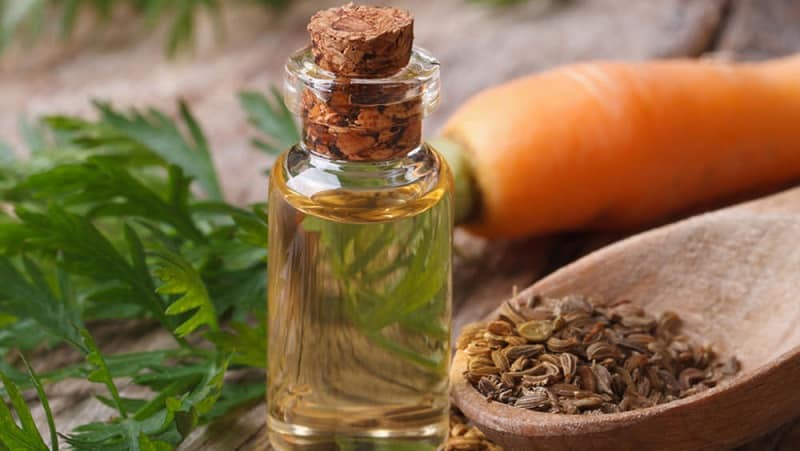
In cosmetology
Dill oil is added to cosmetics for the purpose of:
- skin rejuvenation;
- eliminate signs of skin aging;
- improving skin color;
- eliminate skin itching;
- reducing swelling under the eyes;
- treatment of acne, sunburn and mosquito bites;
- relieve irritation after shaving.
Mix the product with creams, lotions, shampoos, hair and face masks.
In cooking
The product based on butter and vegetable oils is very tasty.It is spread on bread, seasoned with boiled potatoes, dumplings, vegetable stews, and added to salads.
Advice. Garlic, passed through a press, will add piquancy.
For massage
Essential dill oil is used for rubbing and massage. The product is rubbed into the back of the head, temples, neck, shoulders, hollow above the upper lip, calves, wrists, feet.
Massaging the shoulder girdle will help relieve pain and tension in the muscles. Rubbing your back normalizes sleep.
To improve the functioning of the gastrointestinal tract and reduce gas formation, the oil is rubbed into the stomach, moving clockwise.
For kidney problems and pancreas the product is rubbed into the affected area. Foot massage helps with liver pathologies.
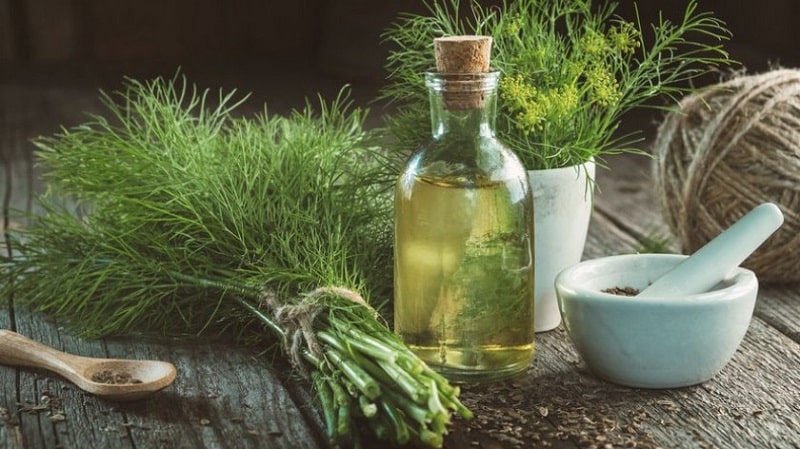
Contraindications
Dill oil has virtually no contraindications and is well tolerated by the body.
Do not use the product during pregnancy, individual intolerance, epilepsy and children under three years of age.
When caring for your skin, be careful not to get the concentrated product into your eyes. If this happens, rinse them with running water.
Conclusion
Dill oil is a valuable product with many beneficial properties. It is well absorbed and rarely causes side effects. Try making a snack butter with dill and garlic and add it to different dishes. And a plant-based product will not be superfluous in your home medicine cabinet.